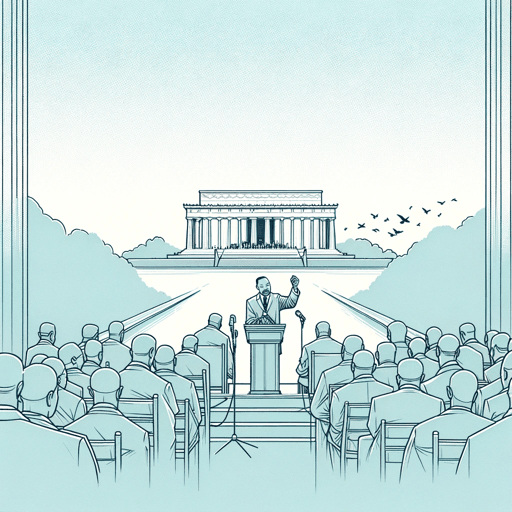28 pages • 56 minutes read
Martin Luther King Jr.I've Been to the Mountaintop
Nonfiction | Essay / Speech | Adult | Published in 1968A modern alternative to SparkNotes and CliffsNotes, SuperSummary offers high-quality Study Guides with detailed chapter summaries and analysis of major themes, characters, and more.
Summary and Study Guide
Summary: “I’ve Been to the Mountaintop”
Martin Luther King Jr. delivered the speech “I’ve Been to the Mountaintop” in support of the striking sanitation workers at Masonic Temple in Memphis, Tennessee, on April 3rd, 1968, the day before his assassination. In his address, King reflects on the tribulations and power of nonviolent civil activism, urging his audience to stand united in demanding social and economic justice. He also alludes to the threats against his life, insisting that he is unafraid and that he foresees a “Promised Land” for all African Americans, even if he does not live to enter it with them. His final speech is replete with the themes of The Importance of Unity and Civil Action, The Power of Selflessness and Personal Sacrifice, and The Endurance of Hope.
This guide uses the transcription available on American Rhetoric. An audio recording of King making the speech is also available on the same webpage.
Content Warning: The source speech and this guide contain discussions of racial violence, segregation, and historical enslavement.
After thanking his friend Ralph Abernathy (See: Key Figures) for introducing him, King thanks his listeners for coming to hear him speak. He then presents a sweeping overview of human history, mentioning Ancient Greece and Rome, the Protestant Reformation, the Renaissance, the Civil War, and the Great Depression before declaring that, if given a choice by God to live at any point in history, he would choose to live in the current era, troubled as it is. King sees the current moment as one in which God is working through humanity and stirring people around the world to demand their rights. Neither these demands nor the challenges facing humanity are new, but King believes that the stakes have become existential: If nonviolence and racial and economic justice do not prevail, humanity is “doomed” (Paragraph 13).
King then shifts his focus to the current situation in Memphis. King’s speech takes a biblical turn, drawing parallels between the Exodus story and the civil rights movement by comparing the power of the Hebrews in uniting against their enslavement and the latter-day African Americans who are joining together for the cause of civil rights and social justice. King recalls the height of the protests for desegregation, emphasizing how strong and united the nonviolent protestors were in the face of violent crackdowns by the police and civil authorities. King emphasizes the power of nonviolent protest in achieving justice for all. He warns against engaging in violence, as it could distract from the central issue of injustice. Thus, King moves into a call to action: He advocates for peaceful demonstrations as the most effective means of ensuring that their demands are not only heard but acted upon.
King underscores the importance of unity in these nonviolent methods. He contends that unity is indispensable for overcoming injustice, drawing on the successful peaceful protests in Birmingham, Alabama, as evidence. Acknowledging that the path to justice is arduous, King suggests that victory lies not in argument or violence but through economic means. He points out the significant economic power of the Black community and proposes coordinated boycotts as a tool for change. Through the collective mobilization of their economic strength, they can withdraw support from businesses that perpetuate racial injustice, and instead support Black-owned enterprises. He points out that while industries may ignore protests, they cannot afford to ignore the economic impact of boycotts.
King stresses the importance of selflessness in the struggle for civil rights, invoking the teachings of Jesus. He refers to the parable of the Good Samaritan (See: Symbols & Motifs), urging his audience to help the sanitation workers in a similar spirit of selflessness. This reference reflects King’s background as a Baptist preacher, aligning religious values with principles of social justice. He urges his listeners to demonstrate heightened resolve and greater determination in helping those in need, weaving together the strands of economic action, nonviolent protest, and moral responsibility into a cohesive vision for the evolving civil rights movement.
King shares a personal account of his being stabbed in New York City. He details how the blade narrowly missed his aorta, his main artery, which, if punctured, would have been a fatal wound. Doctors told him that had he sneezed, he would not have survived. Expressing gratitude for his survival, King reflects on the milestones he has witnessed in the civil rights movement, including the passage of the civil rights bill and his famous “I Have a Dream” speech during the March on Washington, culminating in his presence in Memphis that day. He links these events to the broader narrative of the struggle for racial equality and justice.
In the final lines of his speech, King openly acknowledges the ongoing threats to his life and the dangerous atmosphere surrounding his presence in Memphis. Despite the risks, he proclaims he is unafraid because he has “been to the mountaintop” (Paragraph 55) and, like Moses, has “seen the Promised Land” (Paragraph 57). From this vantage point, King implies, he has gained a prophetic view into America’s future, which fills him with hope for a future marked by equality and justice. King assures his audience that, even if he does not live to enter the Promised Land with them, they will eventually arrive there as a people.
Related Titles
By Martin Luther King Jr.






